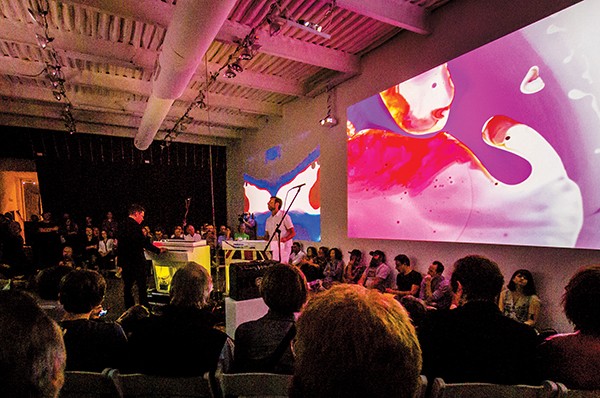In April, 2016, there was a unique concert at Crosstown Arts. Memphis musicians Robby Grant and Jonathan Kirkscey performed original compositions for two Mellotrons. Why was it unique? “No one has ever done Mellotron duets before because you never have more than one of them in the same place,” Kirkscey says.
The Mellotron is a keyboard instrument that is the precursor to the modern sampling synthesizer. “Back in the day, tape technology was the only way to recreate sound,” Grant says. “People wanted to recreate a violin or a flute, they basically recorded the A, A#, B, etc. of a flute and put them on a tape.”
Pressing a key on the Mellotron activates a tape head that presses against the tape loops to play back the sound. Each of the instrument’s 48 keys, therefore, require its own individual 1/8-inch tape, meaning that the mechanism is ungainly and delicate. “They’re pretty rare and relatively expensive for an instrument,” says Grant.
Winston Eggleston, with whom Grant has been friends since high school, is one of a handful of people worldwide who collect Mellotrons. “We spent time hanging out at his house watching The Song Remains the Same,” Grant recalls. “We were synched up musically.”
Eggleston has been obsessed with Mellotrons since the Beatles fan discovered that the ethereal intro to “Strawberry Fields” was produced with one. In 2015, Eggleston told Grant he was going to build his own Mellotron, and Grant suggested putting on a house show. “It was really to just show off the instrument.”
Grant enlisted his Mouserocket bandmate Kirkscey, a noted cellist and composer, to co-write some songs that would show off the Mellotron’s unique sounds and capabilities. “The Mellotron has a symphonic potential that I thought Jonathan would be good at.”
 Jason Schepman
Jason Schepman
with Robby Grant and Jonathan Kirskcey.
Grant and Kirkscey composed nine songs to be performed on a combination of vintage tape-based Mellotrons and the digital emulators created by the Mellotron company. While the analog Mellotrons can only hold three sounds per tape cartridge, the digital versions offer a bank of every sound created for the instruments, including custom tones crafted for Black Sabbath, Tangerine Dream, Yes, and Wilco. Kirkscey says the instruments are idiosyncratic. “The action of the keyboards is not the most desirable. It doesn’t feel like a piano or synth. You have to get used to it. Sometimes there will be one note that’s horrendously out of tune, while all the other notes are in tune. You can avoid that note, or you can embrace it as an eccentricity. In some of those vocal sounds that are recordings of singers, the singers are … not good. Their singing was out of tune! There’s no amount of tuning that can correct that.”
The show took place in the round, with visual effects projected on the walls of Crosstown Arts, created by Eggleston and John Markham, a Californian who learned how to create psychedelic liquid light shows from the people who had created the techniques for Jefferson Airplane in the 1960s. “The question was, how do you do it? Do you do it live, with overhead projectors? I didn’t think that was a good idea.”
Markham and a crew of editors from Archer Malmo created digitally manipulated HD video of the vintage psychedelic effects to be played along with the music. During the final rehearsals, Grant and Kirkscey modified their compositions. “We were reacting to the visuals,” Grant says.
Engineer Kevin Cubbins recorded the weekend of shows at Crosstown Arts, but as the team moved into mix-down mode, tragedy struck. The hard drives and computer equipment containing the recordings were stolen from Cubbins’ studio in a series of break-ins. So the team decided to do it all over again. “I felt bad for Kevin, but I wasn’t upset at the prospect of re-recording,” says Kirkscey. “It’s another chance to do it better.”
The second takes came from a private session at the Eggleston Artistic Trust, with Kirkscey supervising the recording. “I realize now that trying to do all of it — the show the visuals, and the recording — at once was probably too much,” says Grant. “This allowed us to focus on the songs, and focus on the recordings. Jonathan did an incredible job of mixing and editing everything.”
The finished album, Duets for Mellotron, is a gorgeous collection of sounds. There are nods to composers like Philip Glass and Brian Eno, but the overall vibe is unique. The album’s release on Friday, January 13th will be celebrated with a listening party at Crosstown Arts, beginning at 6 p.m. Grant says there are plans afoot for a second live show once the new Crosstown Arts facility opens in the Concourse building.